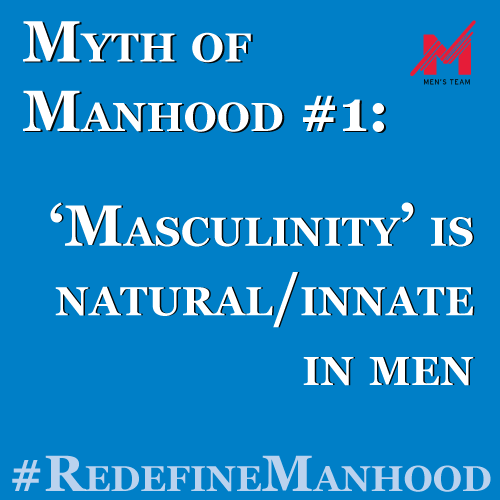By Christopher Ford
Beginning today and continuing into next year, I will be writing
periodically as a part of a new series of blog posts here at The Men’s Team Blog that I would
like to call The Myths of Manhood. It’s something a
little bit different from our regular posts discussing violence against women,
since the focus of this series is, as you can probably tell, men and
masculinity.
But that does not mean it will be disconnected from the subject.
Many folks often forget that violence and violence against women is by and
large a men’s issue — according to Statistics Canada,
approximately 8 out of 10 cases completed in adult criminal courts in Canada
(2012) involved a male accused, and approximately 97% and 91% of persons
accused of sexual offences and weapons offences respectively were men.
Furthermore, the largest age group of criminal offenders in
Canada is men between the ages of 18 and 24, with the second largest being men
between 25 and 34.
And so I affirm: we need to stop talking about violence
against women as if it is a women’s issue. We need to
recognize the massive role that socialization has on the behaviour of men (and
the way others view men) if we ever want to put a stop to violence against
women (and violence in general).
This is where the idea for this new series came from. I thought
that I could investigate some of the ideas about manhood that derive from the
patriarchal society in which we live, and to try and refute them. I will start
with one for today, and then pick up next time with three more.
Myth: ’Masculinity’
is natural/innate in men
This will be a good myth to start off with, since many other
myths about manhood are contained within (and we will be able to talk more
about them later on!). But, basically, one of the fundamental myths of manhood
is that every man is endowed naturally with ‘masculine’
characteristics and behaviours — you may have heard this myth phrased
in different ways, such as “boys will be boys”
or “it’s in our nature to be XYZ (sexually
aggressive, tough, etc).”
Let’s try to unpack this a little bit.
First of all, what do we mean when we say ‘masculine?’
The term masculinity for us — and indeed for our society —
means the equation of manhood with violence, dominance, lack of emotion,
physical strength and toughness, an insatiable drive for sex (with women), and
other similar characteristics.
Now, some folks are of the belief that these characteristics of
manhood are genetically inherited by all men, or, to put it another way, that
to be a man (read ‘to have a penis’) somehow means
that you are predetermined to have character traits like those listed above.
And at some level, yes, genes may play a role in the way we behave. However,
behaviours that our society ascribes to ‘masculinity’
are very often the products of the socialization of men through culture —
and very often the sheer power of socializing forces is altogether
ignored.
I know — some of you may be shaking your head
in disagreement. But consider the following study performed by Margaret Mead,
one of the most influential anthropologists of our time.
In her book, entitled Sex and Temperament in Three Primitive
Societies (1935), Mead studied three tribes in the region of modern-day Papua
New Guinea. Although residing not too far away from one another, she found
considerable differences in the ways men behaved, as well as the gender norms
and roles for both men and women, between the tribes.
For the first tribe, the Arapesh people, she said that “both
men and women were peaceful in temperament and neither men nor women made war”
(although she does say that war did sometimes happen, but not very
often). She also said that the Arapesh showed a considerable amount of
egalitarianism, placing particular importance on egalitarian child-rearing.
Regarding the second, called the Mundugumor people, she said that
“both men and women were warlike in temperament”
— that is, violence was not something
attributed to manhood or the nature of men, but it was a large part of the way
their society functioned.
And, lastly, the third tribe, the Tchambuli, she said “were different from both. The men
'primped' and spent their time decorating themselves while the women worked and
were the practical ones – the opposite of how it seemed in early
20th century America.” The Tchambuli men displayed many
characteristics that we would associate with ‘femininity’
here in the West.
Yet, for all three of these tribes, men were not considered as
any less masculine by the standards of any society but our own.
And so, in closing, I would like to say the following: we live in
a culture that teaches men that they must be independent (i.e. like the
protaganist in any American Western film, to not rely on anyone but
themselves); that they have natural desires such as desires for sex and for
violence that are insatiable (i.e. boys will be boys, or the myth that men
think about sex every seven seconds); and that, in order to be a ‘real
man,’ they have to be successful.
However, ‘to be successful’
as a man in our society often comes at the expense of others. According
to our culture, the idea of success for a man living within it becomes
conflated with the achievement of dominance over others, often either through
physically overpowering another person or, as said by educator and entrepreneur
Hamza
Khan at White
Ribbon’s What Makes a Man
conference this November, through “having things.”
I will continue to unravel and overturn this myth and many others
in later posts.
Stay tuned for the next Myth of Manhood — coming soon!

No comments:
Post a Comment